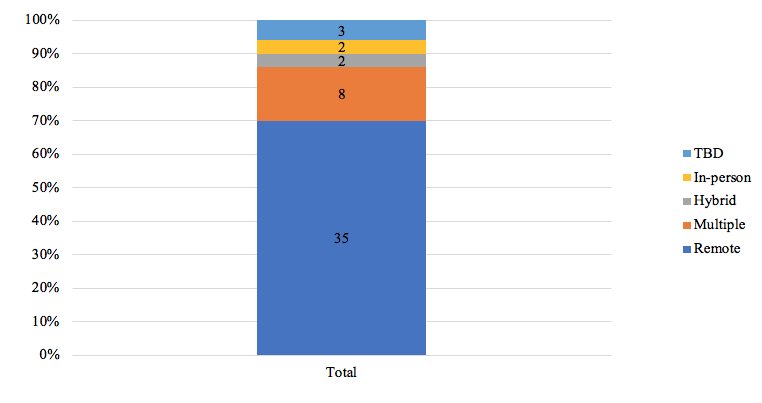
Parents are conflicted about what to do with their K-12 children next fall. They have doubts about the safety of sending their children back to their local in-person school until a Covid-19 vaccine is developed. They also know that remote learning, as currently instituted, places unreasonable burdens on them.
Solving this dilemma will require redesigning the division of labor within K-12 public education—even if that entails stepping on some powerful toes.
Over the centuries, the division of labor within K-12 education has changed fundamentally. In 18th century America, teaching was primarily a home-based, private, and unpaid occupation. By the late 19th century, it had evolved into a school-based, public, and paid occupation. But it also remained primitive by modern standards, as it was usually located in a one-room schoolhouse taught by one teacher teaching K-12 students of all ages and skill levels. By the late 20th century, it had evolved into a schoolhouse with more than ten times more rooms, each filled with specialized teachers teaching many different subjects to highly segmented students.
During these 300 years, a common feature of the division of labor was that the most valuable educational resources were delivered locally.
The Covid-19 pandemic, combined with the advent of modern information technology, has created huge pressure for a new division of labor between local and remote education services, because the safest way to learn is remotely. But economic pressures favoring more remote learning had been building long before Covid-19. These pressures included much greater economies of scale, personalization, and competition in the provision of remote K-12 education. Economies of scale because the market for basic courses could encompass millions of students; personalization because large markets combined with smart technology facilitate student segmentation, including adjusting the pace, style, and content of learning to the individual student; and competition because neighborhood schools intrinsically have more monopoly power than remote ones.
But given the political power of the current K-12 incumbent education producers, remote learning was built on a rotten foundation, one where those incumbents had veto power over change. To be sure, all remote learning must be built on a strong local learning foundation, including humans in conveniently located in-person spaces who provide students with safety, motivation, and coaching. But because the shift to remote learning entails reduced economic and political power for the local incumbents, the incumbents worked to control and slow it down.
The current shift to remote learning has exposed that rotten foundation. For the small fraction of parents willing and able to devote themselves to homeschooling, the foundation is reasonable. For the rest, it is not only unreasonable but undermining the basis of modern prosperity and civilization, which depends on most parents working in highly specialized occupations other than education.
In an ideal world, traditional in-person schools could be repurposed to provide the needed local education services at affordable prices. In the real world, though, that won’t happen reasonably soon.
First, the politically powerful local educator unions will fiercely oppose any reform in their school buildings that is perceived to reduce their members economic and political clout.
Second, many current K-12 school buildings cannot provide the needed services because they lack the space to provide the minimum required social distancing. Thus, many can only provide in-person classrooms to students for part of the school week, and additional spaces will be needed for full-week access.
Third, even with reduced student counts in K-12 school buildings, many parents, teachers, and healthcare experts believe the healthcare promises of K-12 school policymakers lack credibility. The building spaces are too large and unmanageable to keep hygienic, and expecting hundreds of impulsive students to follow written social distancing guidelines defies human nature.
Parents are more likely to trust a place of learning if its space is relatively small and manageable, they can choose it, and competitive pressure forces genuine accountability—such as allowing parents to remotely monitor the space, something teachers’ unions have never allowed. During Covid-19, parents and policymakers have been much more trusting of childcare than K-12 school spaces; for example, state authorities allowed childcare to stay open for the children of essential workers even when K-12 schools were completely shut down. I call such places, when they strive to replicate the best that parents bring to their children’s K-12 remote learning, “nurture centers.”
The public policy model that best applies to learning centers would be existing pre-K childcare licensing and student subsidy programs, not existing public K-12 schools. Accordingly, nurture center licensing should include provisions for home-based, work-based, and specialized childcare facilities. It should also allow for close substitutes, such as underutilized restaurant spaces. Those spaces already pass many of the health, safety, bathroom, and other requirements for childcare facilities, and they are also set up to provide the internet connectivity and nutrition that many underprivileged students lack at home.
Unlike childcare centers, nurture centers are not self-contained learning spaces. Instead, they would be powerful platforms to enable access to external resources, including the vast, competitive, and innovative world of remote learning. This is also what distinguishes them from the currently most widely proposed versions of K-12 “microschools” and “pandemic pods.” The adults who supervise nurture centers should be, like parents, only “learning coaches,” not comprehensive teachers such as those who currently work in K-12 in-person schools.
Congress is currently crafting legislation to increase childcare spending for pre-K children while excluding childcare that might compete with K-12 public schools. Congress is also considering coronavirus related subsidies for K-12 public schools, including funding for technology and healthcare. Nurture centers should be eligible for both types of funding.
In the future, policymakers should view the Yin of local education as inextricably linked to the Yang of remote education, and the proper balance between them as a fundamental policy lever.
America’s current system of remote learning is highly unbalanced, with more than 95% of dollars allocated to local rather than non-local providers. Everywhere else in education we’re constantly told you-get-what-you-pay-for. Why not remote learning providers, too? Resources should be shifted to remote learning based on a provider’s quality of services, not its location. This shift will also require focusing local education dollars where they can add the most value: to specialized nurturers.
No one familiar with K-12 education politics will think such a transition easy to implement. But if there ever was an opportunity to make the transition, it is now. Parents are in agony over making impossible choices, and much of the economy depends on overcoming the Hobson’s choice the K-12 education establishment has foisted upon us. The way out of the dilemma is public policy that supports a new division of labor between remote and local education, creating options worthy of the technological capabilities and education needs of our times.
J.H. Snider, president of iSolon.org, often writes about K-12 education policy and politics.
Read more from Education Next on coronavirus and Covid-19.





